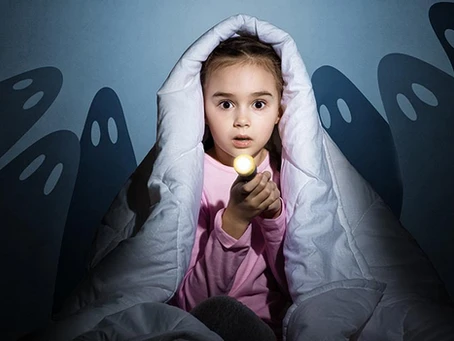Tackling fear in children

Fear can have crippling effects on both children and adults. Most people have some sort of irrational phobia; maybe it’s spiders, tight spaces, dogs, or just a general fear of other people. What you have to remember is that most fears are entirely illogical and based primarily on our preconceived notions about people and things. Some of these fears we develop through past experiences, for example, maybe a dog bit someone when they were young, and now that fear of dogs has followed them into adulthood. Another way that we can develop irrational fears is by inheriting them. Children learn from example, and if they see an adult in their lives exhibit a fear such as a fear of heights, then the child is much more likely to develop that fear themselves. Dr. Francine Rosenberg, a clinical psychologist and anxiety specialist at Morristown Memorial Hospital in New Jersey, said, “This learning occurs through parents’ verbal and nonverbal cues to their children.” The best way to prevent children from inheriting their fears or phobias is for adults to acknowledge and evaluate the validity of their own fears. Once we can confront and control our anxieties, it becomes easier to help our children navigate their own. Here are four ways that I’ve found to help guide my kids through their own fears.
1. Take your child’s fear seriously – Although some fears may be irrational, they are all very real and can have devastating effects on our mental state. The fear of interpersonal human aggression can be very frightening and cause us to avoid interacting with others. The fear of financial loss, the death of a loved one, or sickness are all genuine and relevant fears. As adults, we deal with these fears as best we can, and we try not to let the effects of this fear spread to our children. In doing so, we can sometimes forget that our child’s fear of “the monster under the bed,” although irrational to us, is just as real and scary as the fears you have as an adult. Allow your child to express their concerns without judgment. Acknowledge that the fear exists, and then you can begin to work through it together.
2. Work together – “Once you’ve offered reassurance, it’s important to move on quickly,” says Dr. Rachel Busman, a clinical psychologist at the Child Mind Institute. ”We don’t want to dwell on offering comfort around the scary thing, because even that can become reinforcing and take on a life of its own.” Instead, start talking about how you’ll work together to help your child start feeling braver and get to the point where they’re able to manage the fear on their own.
3. Give your child control – Both of my daughters use to have an issue with going to bed on their own. Both wanted me or their mom to stay in their rooms, sing, tell stories, play…anything but sleep. Eventually, we had do develop a plan to control their fear of being alone at night so that we could all get to bed at a reasonable hour. The idea was to get them putting themselves to bed by the end of the month and went something like this:
· Week 1: Business as usual, but we started talking to the girls more seriously about why it was important for them to start putting themselves to bed.
· Week 2: We would read one story, sing one song together, and then mommy or daddy would tuck them in, turn off the lights and be right down the hall.
· Week 3: We would read one story or sing one song (not both). Then, the girls could turn off the lights themselves, and we would all go to bed.
· Week 4: We could read and sing before bedtime, but once the girls were in their rooms, it was their responsibility to turn their lights out and put themselves to bed. By slowly allowing our girls to take more control over their own routine, they began to feel more independent and less fearful. You have to remember that this exchange of control takes time and won’t always be easy. But try to be encouraging. Compliment your children on their bravery and let them know that you’re proud of them every chance you get.
4. Don’t use fear as a tool – One thing that’s always bothered me is when I see adults using fear to control children. Fear of abstract concepts like “the boogeyman” are perfectly normal, but parents often use authoritative figures to scare and regulate their children’s behavior. A good friend of mine used to be a uniformed police officer in Las Vegas. He once told me a story that perfectly illustrates how using fear to manage your children is a bad idea. Like most police officers, he would take overtime shifts wherever he could to help make ends meet. One night he was working in a local shopping center where a woman entered with a very unruly young son. When the woman realized that she wouldn’t be able to control her child, she pointed at my friend and said, “Do you see that police officer over there? If you don’t behave, I’m going to have him arrest you and take you to jail. Is that what you want?” My friend approached the woman, and calmly informed her that what she was doing was counterproductive. She may have felt that what she said would help control her child, but what she had actually done was instill in him an irrational fear of police officers. Now, if he ever found himself in trouble or separated from his mother, his natural inclination would be to avoid the police officer as opposed to seeking help.
Parents have to pay close attention to the fears of their children, and in most cases, we have the tools we need to help them work through their anxieties. On the other hand, if your child’s fears are persistent, overly intense, or begin interfering with their daily life, it might be time to seek some outside help. According to The Child Mind Institute, signs that a fear may be something more include:
- Obsessive worrying: Your child fixates on the object of their fear, thinking, or talking about it often, or even when the trigger isn’t present. For example, becoming terribly anxious months before their next dentist visit.
- Fears that limit your child’s ability to enjoy their life or participate in activities. For example, refusing to go on a class trip to the park because there might be dogs there.
Look for signs of severe anxiety like panic attacks, compulsive or disruptive behavior, or withdrawing from activities, school or family. If your child’s fears seem like they might be something more serious, make an appointment to talk with a professional to see if more help is necessary. Once we understand how important it is to set a good example by controlling our own fears, we can start working together with our children to help them master the skills they’ll need to tackle their own.
Stay safe and keep your head up!
Gary Quesenberry
